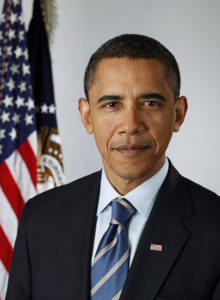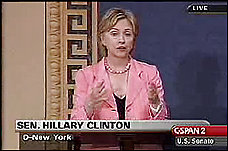How To Dress For A Media Interview: Attire
This is the second in a week-long series that will teach you how to dress, apply makeup, and wear your hair for media interviews and public appearances. You can see the complete series here.
When dressing for television, don’t be too fancy!
Instead, “wear plain colors and patterns that don’t do anything,’” as Lillian Brown says in Your Public Best: The Complete Personal Appearance and Media Training Guide.
Solid colors convey “more authority and sophistication than a print,” advise Deborah Boland and JoJami Tyler, co-owners of the media and image consulting firm TV Image Live. But not all solids are created equal: “Pastels have always been flattering on TV, but the message they send is soft,” Boland and Tyler say, so eschew them if you’re in a hard-edged field such as finance or law. If you must wear prints, avoid patterns such as stripes, polka dots and checks, all of which can appear to vibrate or shimmer on television.

President Obama Wears a Solid Suit, Solid Shirt, and a Broadly-Striped Tie For His Official Portrait. Wikimedia Commons Photo: Pete Souza/Office of the President-Elect
With the advent of HD, there are no longer colors that are taboo on television (continue to avoid red, black and white for non-HD videos). But white works best under a jacket so it doesn’t wash out your face. And ask the producer if there are any caveats for their set – you wouldn’t want to wear a green suit on a show with a green background, for example.
Such considerations aside, you typically can’t go wrong with most grays, blues or brown-based earth tones. But add a bit of variety. “High color contrast makes you look sharper and more authoritative than monochromatic looks,” say Boland and Tyler.
Men’s suits should hang well, and their hems should be long enough to avoid exposing your legs while seated. Wear long, dark socks and an understated tie, and make sure your shirt collar (which frames the lower part of your face) fits well. If you favor pocket squares, pick a dark color that coordinates perfectly and is well-folded.
Women should pay attention to their necklines. “A v-neck or scoop neck top on a woman is more flattering and makes you look slimmer,” say Boland and Tyler. “It also helps with microphone placement. And if you think a top may be too low cut, it is.” You don’t want to wind up like Hillary Clinton, whose slightly exposed cleavage got the wrong kind of press attention when she was a member of Congress.
Before you go on air, brush your lapels and shoulders if there’s any chance they may be adorned with dandruff, pet hair or baby spit-up. And remember to unbutton your jacket’s bottom button when you sit down, in order to keep the lapels straight. Jackets will also look better if you tuck the ends under you when you sit.
Most important, you should feel comfortable. For that reason, don’t wear an outfit for the first time in an interview.
You can see the other articles in the series here.
Many of these tips were used with permission from Your Public Best: The Complete Personal Appearance and Media Training Guide by Lillian Brown. Published by Newmarket Press.
